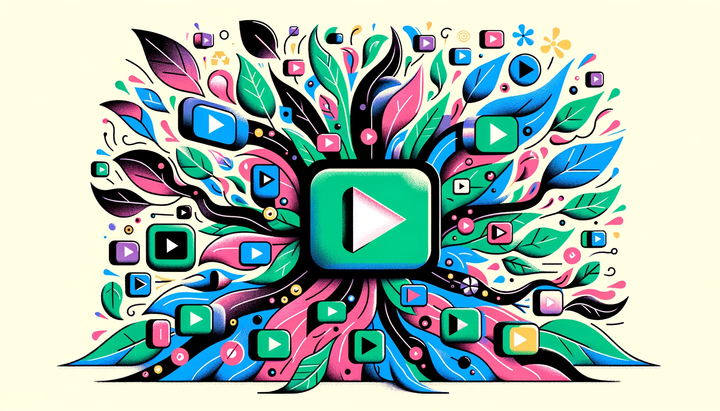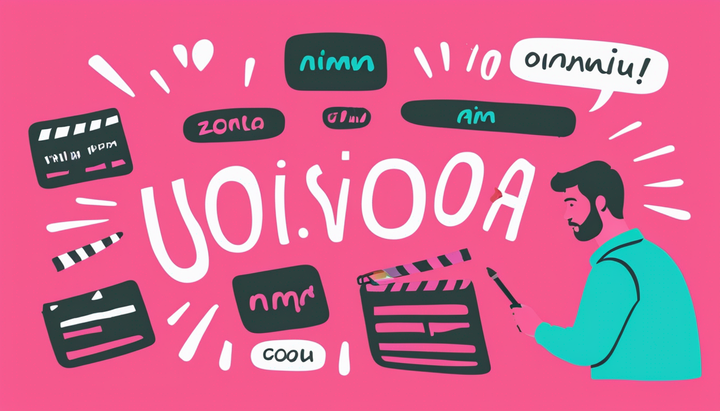The 10 Video Marketing Trends that Matter in 2024
We've rounded up the top video marketing trends of 2024 (and made some predictions for where we think video is going next year) to help you level up your video content strategy.
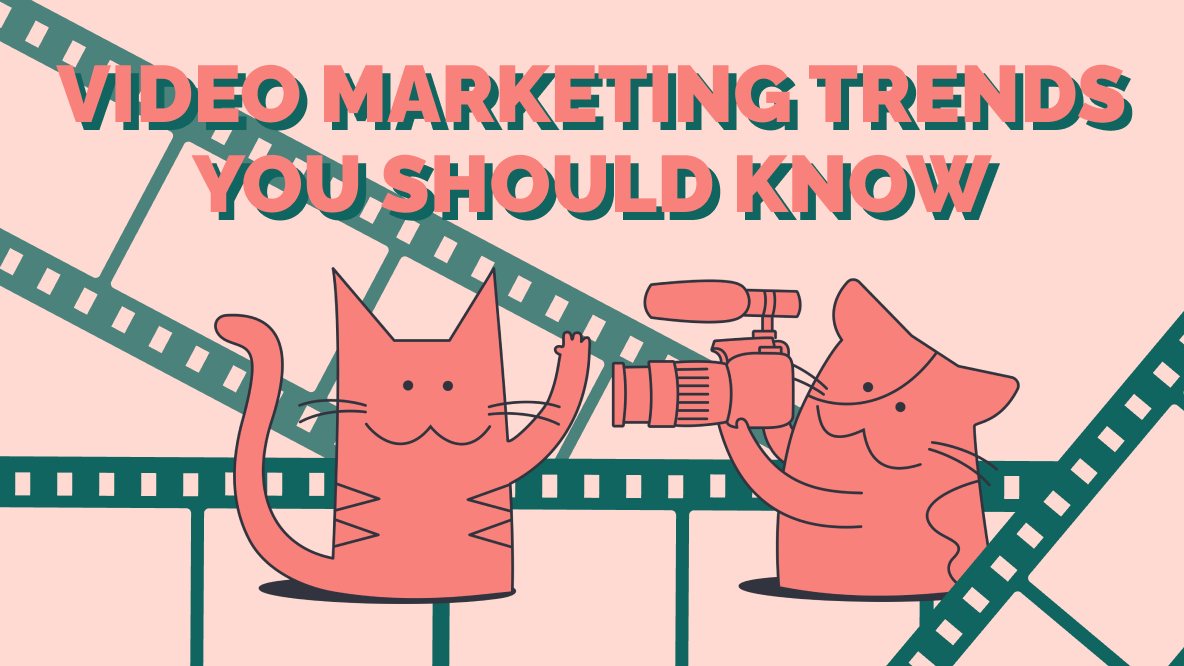
As a digital marketer, you know that online behavior is changing at the speed of light. It’s your job to keep with the bleeding-edge trends in content marketing to stay relevant and ahead of the curve.
The hottest and most enduring “trend” in marketing is undoubtedly video. It wasn’t that long ago that TikTok wasn’t taken seriously, written off as an app for dancing teens. Fastforward and short-form video is everywhere, with Shorts, Reels, and other platforms following suit.
Now, any marketer worth their salt is fluent in online video. In fact, it’s less of a trend and more of a standard. And if you dig down further, you’ll find trends within video marketing itself.
Here, we’ll dive into the video marketing trends that are defining 2023 and that marketers absolutely need to know.
Why use video marketing in 2023?
Video in marketing is no longer something that’s nice to have, it’s an absolute essential. The internet has coalesced around video-first content and your marketing strategies should reflect that.
If you prioritize video content, you’ll be in good company. Wyzowl’s 2023 video marketing trends report found that 91% of businesses use video as a marketing tool — up from 86% in 2022, and a huge jump from 61% in 2016.
And 96% of marketers said video was an “important part” of their marketing strategy, which is the highest percentage in all nine years Wyxowl has done their survey.
Marketers also agree that video is a worthwhile investment, with 92% reporting a positive ROI. Again, more marketers said that in 2023 than any other year. Even for those who aren’t currently using video, 70% said they planned to start in 2023.
So why are marketers so obsessed with video? The answer lies with the fact that people watch videos more than ever.
According to Statistica, three billion internet users watched or downloaded a video every month in 2022, and that number is only expected to increase. No wonder video accounts for 82% of internet traffic. The rise of social media sites like TikTok and Instagram have also made video ads essential. It’s estimated that $78.5 billion will be spent on video ads in 2023.
Using the internet is now synonymous with engaging with video content, so if you don’t have a video marketing strategy, you’re being left far behind. Use these video marketing trends, along with other marketing trends, so get ahead and stay ahead.
6 B2C and DTC video marketing trends
Let’s take a look at the video marketing trends popular with B2C and DTC businesses.
1. Short-form video
When TikTok came along, it totally revolutionized video. Sure — short-form video existed before TikTok. You might remember Vine, for example. But TikTok ushered in an era of short, vertical videos and they’ve reigned supreme ever since. Short-form video has been adopted by every major platform, from Shorts on YouTube to Reels on Instagram.
When we think about short-form videos, they’re usually under one minute and sometimes less than 15 seconds. They’re meant to be punchy with an immediate hook that draws viewers in, and with a punchline not far behind.
According to Hubspot, short-form video is by far the most popular format that video marketers use on social media at 54%. Long-form videos trail behind at 36%. Marketers also reported that short-form video has the highest ROI of any video.
It’s also become a rather convenient format because the same clip can be reposted as a TikTok, Reel, and YouTube Short.
These short clips are meant to be entertaining and highly digestible, encouraging people to spend hours scrolling an endless feed. That means short-form videos also need that wow factor. Using humor is the most common tactic to get that done and even brands with a more serious tone elsewhere often adapt their short-form videos to be more light-hearted.
Short-form videos also have their own trends, including memes and trending audio, which most often originate on TikTok. Playing into those trends is another way to find engagement.
Here’s an example from Scrub Daddy’s TikTok:
@scrubdaddy That one hurted. #scrubdaddy #smile #cleantok #cleaningtiktok #americasfavoritesponge ♬ ok its got a little kick - em
It’s only eight seconds long and may seem incomprehensible to those who aren’t native TikTok users. But it uses a popular piece of audio and a meme-style format. It appears simple, but has over one million views.
Short-form video also creates greater efficiency for content teams because it provides more places to repurpose your existing content. This can be as simple as creating clips of longer videos and resizing them for social media platforms. Or, if the original content isn't well-suited to being resized and reformatted, it might look more like content atomization, where you take a key theme or idea from existing content and use it to create multiple assets across channels.
2. User-generated content for organic posts and video ads
User-generated content, or UGC, is popping off all over the place, especially from DTC brands.
UGC is video content that is created by regular social media users, as opposed branded content or video content made by a paid influencer. That could look like someone posting a review of a new product, doing an outfit-of-the-day video, or even showing a recipe that uses a particular product.
However, user generated content has expanded to also include UGC-style video content. It’s made to look like it was created organically by an everyday person, but was actually crafted in-house by a brand or a freelance UGC creator commissioned by a brand. When it’s done well, you can’t really tell the difference. That makes user generated videos ideal for paid video advertising as well as more guerilla organic marketing.
In either case, UGC has become popular because it feels authentic. The deinfluencing trend revealed how many people are skeptical of influencer content, being left wondering if the influencer in question genuinely recommends a product or is just being paid to do so.
UGC on the other hand signals that the person in the video actually uses and enjoys the products they’re showcasing. They typically don’t have the polish of a brand or influencer-produced video, but that just adds to their authenticity. That builds trust with viewers who prefer watching videos from relatable users.
There are two ways to go about using UGC. First is to search social media for video content created organically by fans and then reposting or licensing their video content.
The other option is to work with professional UGC creators who make this style of video. The advantage to working with a UGC creator is that you can ensure you’re getting the right message across while still keeping that UGC feel. These videos can then either be shared on a branded channel, or appropriately tagged and shared by the creator.
Savannah Sanchez, known as @Social_Savannah on Twitter, is a professional UGC creator who often shares her work.
Here’s a thread where she shares some UGC-style hooks, with examples.
Marketers, listen up👂!
— Social Savannah (@social_savannah) August 25, 2023
I'm letting you in on my 8 top-performing ad formats. You need to be testing these before Q4!
#1 "3 things that will convince you to try _____" pic.twitter.com/ni9dPPCbzD
3. Live video
Virtually every social media app that offers video also offers a way to stream live, and people are definitely watching.
According to Insider Intelligence, live streaming saw a major surge during the pandemic. It was estimated that live video viewers in the US would reach 163.4 million by 2023. As well, nearly half of the US population has streamed a live video. And, according to Livestream, 80% of people would rather watch a live video from a brand than read a blog post.
One of the advantages of live streaming video is that these are interactive videos. Viewers can ask questions or leave comments in real-time that you can respond to, and different social media networks allow for different reactions such as emoji or special animations.
Twitch has been a pioneer in live video, particularly for brands in the gaming space, but there are live video options on TikTok, Instagram, and YouTube as well. After a stream is done, the video can also be cut into clips with a video editor for both short-form and long-form videos.
Some brands also host shoppable videos. And it’s not just legacy e-commerce channels like Amazon that support live shopping. The advent of TikTok Shop means that TikTok Live streams can now be shoppable videos, too, with the ability to purchase an item on screen just a click away.
4. Educational video content
Company blogs were once the main format for educating customers and prospects, but now video has taken over.
Video marketing is an excellent method to connect consumers with the information they need about your products, such as how to use them, how to put them together, or how to build a routine.
The visual nature of videos makes it easier to communicate concepts to your customers and can act as a proactive customer support channel. In fact, in that Wyzowl survey, 70% of marketers said they created explainer and how-to videos.
It’s also the preferred medium for customers to learn about your brand — 96% of people said they had watched a how-to video to learn more about a product or service. Additionally, 89% of people said watching a video convinced them to buy a product or service.
Educational videos can take on many forms, from quick hits of information to long-form explainer videos.
Here’s an example of a short TikTok from skincare brand Neutrogena busting myths about skin hydration, using simple text and a voice layover.
@neutrogena_us True or false? #skinscience #trueorfalse #skintok #neutrogenahydroboost #neutrogena ♬ Funk Hip Hop Music(814197) - Pavel
And here’s an example of a long-form educational video from DTC bidet brand Tushy that explains how to install their product.
Either way, the end result is connecting customers with information that helps them make the most of each brand’s products.
5. Behind the scenes
The new era of video marketing is less about polish and poise, and more about offering something genuine to your viewers. You might call this the “TikTok Effect.” Authenticity is the number one currency on the social media platform, and that has leaked into video content all over the internet.
One way to show off the authentic side of your brand is with behind-the-scenes video marketing. In this video marketing trend, you take customers into the inner workings of your brand, showcasing the people, processes, and values that define your business.
The value piece is very important here. Studies have shown that Gen Z in particular really cares about buying from brands whose values align with their own. According to Snapchat, 63% of Gen Z favors brands that have fair labor policies and treat their employees well. As well, 63% prefer brands that promote inclusive workplaces, and 62% prefer brands that have sustainable manufacturing processes.
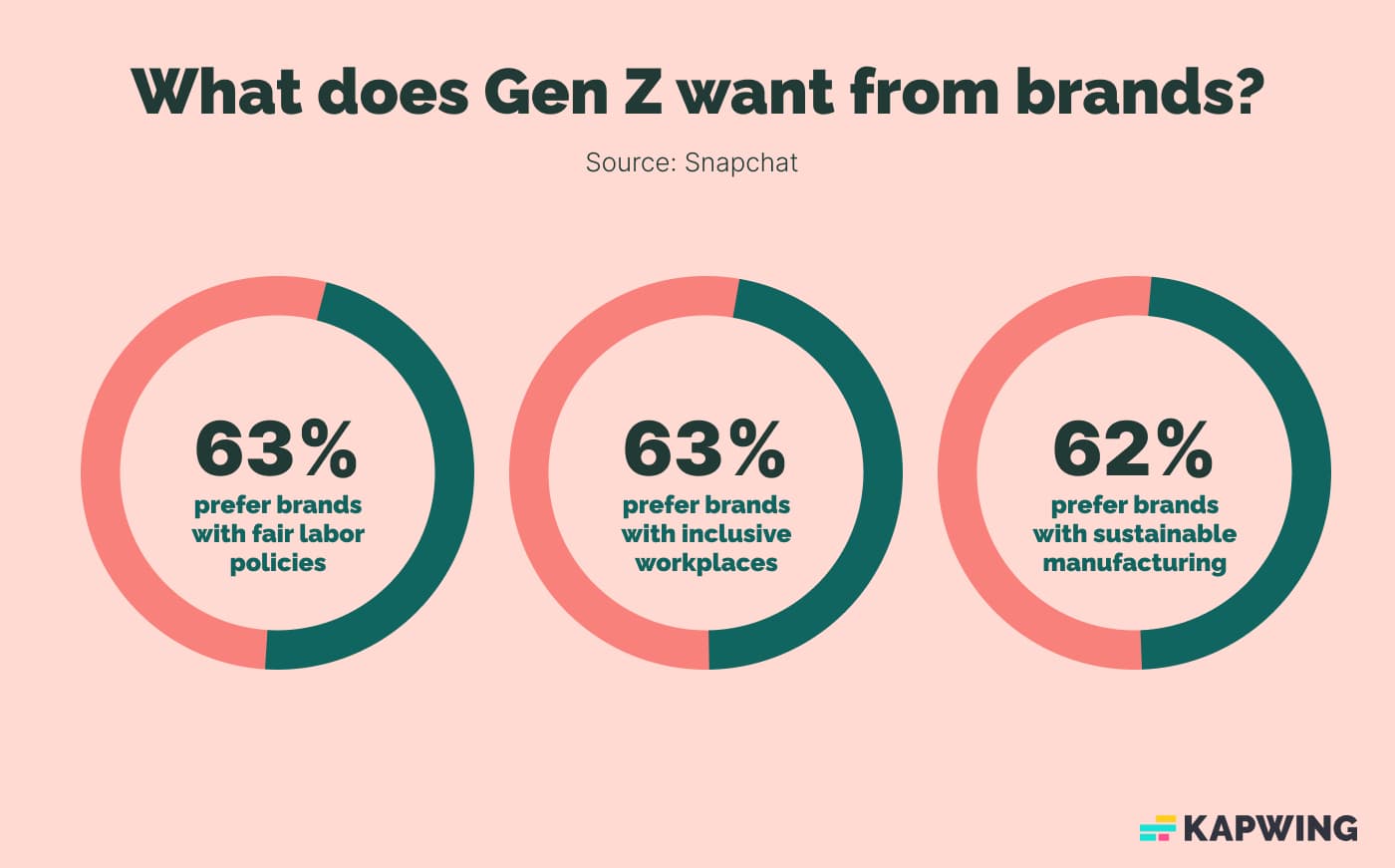
If those values matter to you too, behind-the-scenes videos are a great way to show that. These can be shared as organic posts on your social media channels, or even part of a larger paid video marketing campaign.
There are a few ways you can incorporate this trend. Dental care brand Hismile, for example, often shoots its social media videos in its warehouse. The TikTok below is a straight-forward sell, but it also offers a glimpse into where their employees work.
@hismile The future is looking BRIGHT ✨😬 #fresh #tasty #fun ♬ original sound - hismile
You can also produce more in-depth, long-form videos looking at, for example, the launch of a product. This YouTube video from ColourPop Cosmetics tells the story of the brand’s collaboration with Disney, and how they worked with Disney designers to create it.
6. SEO for videos
Finally, the last video marketing trend is the emerging importance of video in SEO, or search engine optimization.
Video marketers have been aware of the importance of solid video SEO practices on YouTube videos for the past few years, but those principles are increasingly being applied to social media platforms like Instagram and TikTok. Search engine results pages, like on Google, now show TikToks, but Google can only find your content if you’re writing descriptions and using tags with SEO in mind.
This is also an important practice because for younger generations, TikTok is the new Google. You may be surprised to hear 51% of Gen Z start their searches on TikTok because they prefer answers to be in video format.
Search optimized videos are only going to become more prevalent, so don’t get left behind.
4 B2B video marketing trends
Next, we’ll look at video marketing trends that have popped up in the B2B space.
1. LinkedIn videos
As a B2B business, you already know the power of LinkedIn. You should also know that engagement on the network is growing.
LinkedIn reported a 22% growth in user sessions in 2022. LinkedIn also boasts over 930 million members. It’s also equipped to handle native video, whether short or long.
Whether you’re trying to attract new clients, introduce a new product, share a webinar, or find new employees, video is a great marketing tool on LinkedIn and companies are posting more video than ever to the platform. You can even stream live videos on LinkedIn and post them as featured videos on your profile after the event.
For example, Salesforce live streamed Dreamforce 2023, their annual event.
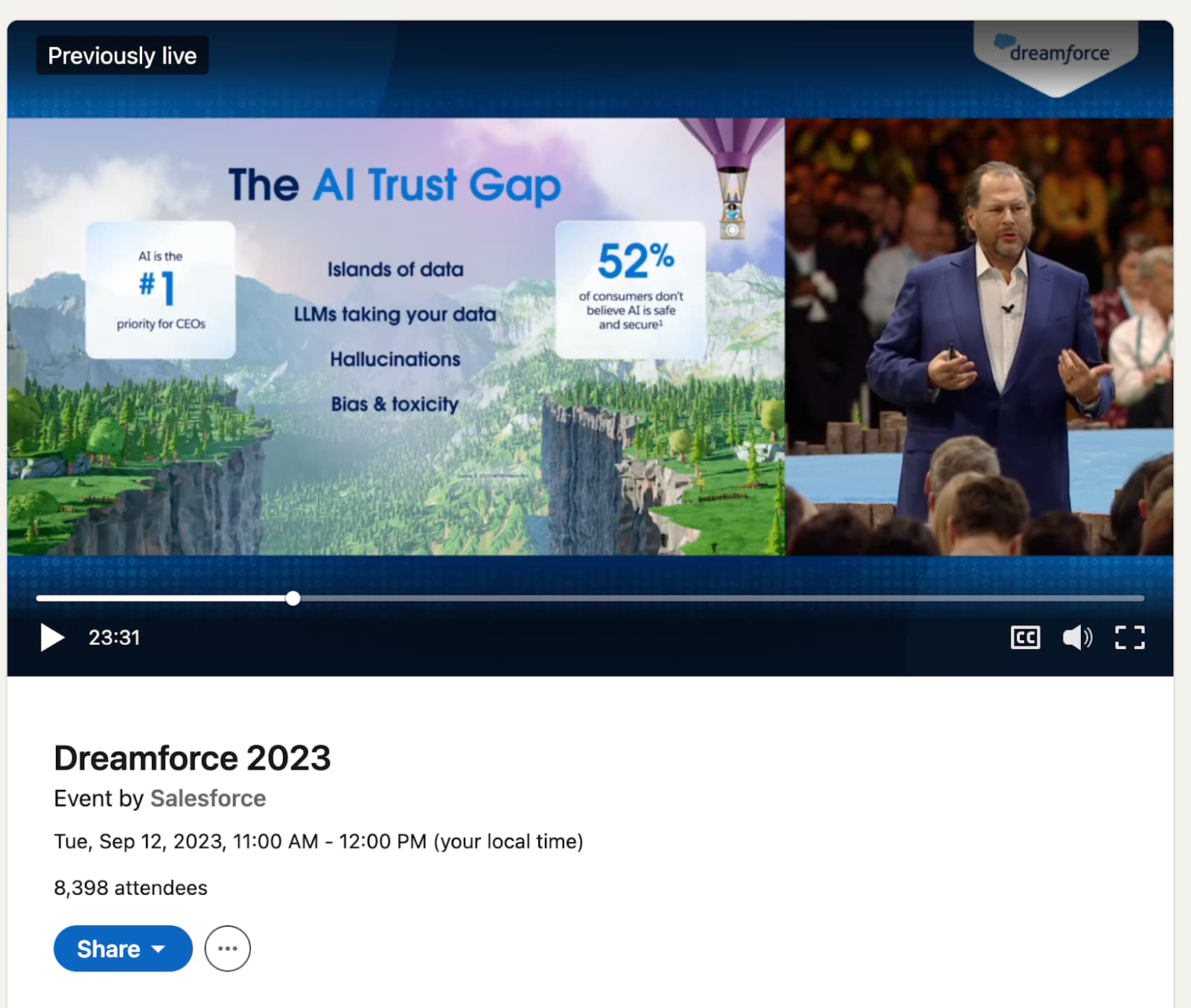
2. AI video
One of the most talked-about video marketing trends is AI. The rise of artificial intelligence has made it easier than ever to create video content with ease.
In that Wyzowl study, 41% of brands that only started with video marketing in 2022 said it was because videos had become easier to make in-house. AI automates many processes that make video creation difficult, from editing clips to even using an AI avatar as a video host.
For busy video marketers, AI tools simplify video creation. Kapwing has AI-powered tools to edit clips and audio, remove background noise, generate video scripts, and create subtitles.
What’s especially exciting is that AI can be used to make complete marketing videos from scratch. Kapwing’s AI video generator can create a video from a single text prompt, pulling in facts, text, audio, images, b-roll, and transitions. The videos can be used as-is, or further edited and refined, or you can resize the video to use on different platforms.
3. Going live with webinars
You have oodles of information you need to communicate to clients and written content isn’t always the best way to get it done. Remember the stat that 80% of people would rather watch videos from a brand than read a blog post? The same is true in the B2B world. A video can communicate concepts much more easily than text.
That’s why webinars have become one of the top video marketing trends among B2B companies. A webinar is a virtual event, usually with several guests, that is live streamed and then most often archived so pre recorded videos can be watched again.
For example, you might host a webinar with some of your clients, demonstrating the value you provided to a new target audience. Or you might host a webinar with several members of your team to provide business updates or showcase new products.
Webinars can be as simple as hosting and recording a Zoom session and uploading the video, or you could use dedicated webinar tools like Wistia, Hubilo, or Zoho.
Here’s an example of an e-commerce webinar from Google that features talking heads along with slides for added visuals:
4. B2B becomes like DTC
Finally, the last B2B video marketing trend to take note of is the ways B2B is increasingly looking like DTC.
This has been a trend across marketing more generally. Traditionally, DTC brands have been able to take more risks with their branding, with punchier voices or more humor. But that’s changing.
B2B brands are taking notes from methods that have worked for DTC brands. In video marketing, that looks like B2B brands now looking to create social media videos for platforms like TikTok, hosting livestreams, using UGC, and even working with influencers. These videos can either be posted organically or put into video advertising.
So if you’re a B2B brand, don’t ignore those DTC video marketing trends — they apply to your B2B video marketing strategy, too.
Video marketing trend predictions for 2024
We know what video marketing trends are hot now, but what does the future look like? We have three major predictions.
First is that AI is going to get even more powerful — not only in how videos are created, but in how they’re distributed. One of the most exciting prospects for AI is the ability to personalize video content for specific audiences. We’re already seeing this with ad placements, but it’s only going to get more powerful. AI will unlock the ability to determine what messaging will most motivate a customer or client, then actually create a video with that messaging.
The next trend we predict we’ll see in the future is greater accessibility to create virtual reality and augmented reality interactive video experiences. VR is an immersive experience that takes you inside a new world, like with using an Oculus virtual reality headset. Augmented reality takes a digital experience and places it in a user’s world, like previewing how a new sofa will look in your own space. Either way, you’re creating interactive videos that take the experience beyond simply watching something on a screen.
The technology exists for both AI personalization as well as AR and VR experiences, what we think will change is their adoption rate and the ease at which a non-expert can use them.
Finally, expect shoppable videos to become the norm in the US. Live stream shopping has already blown up in parts of Asia, and it’s now primed to take over the West with TikTok Shop. All in all, expect to see more interactive video in the future.
Keep an eye out for these marketing trends as you plan your strategy into 2024.
Video marketers must stay current to succeed
When YouTube launched in 2005, it marked the beginning of a shift to the internet being a video-first experience. Technology has only moved at a rapid pace since then, bringing us livestreaming and short-form video. All of that has to be taken into consideration in your video marketing strategy.
Video marketing trends will continue to change and evolve as viewing habits change as new apps and tools become available.
As a video marketer, staying on top of these video marketing trends will benefit your ROI and make sure the right audience is watching videos with your message.
Additional Resources:
- What Is a Brand Kit and Why Should You Make One?
- Video Podcasts: Why Your Podcast Should Always Have Video


